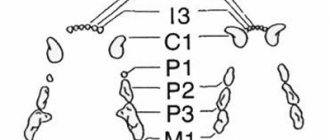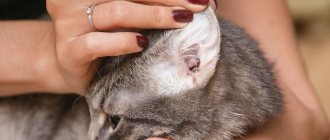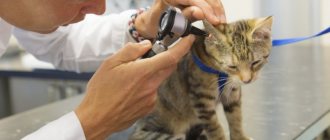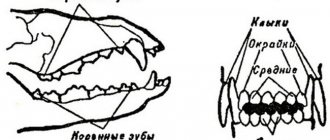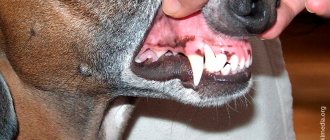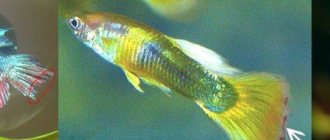Providing competent care for the cat’s oral cavity is an obligatory concern of the owner. Teeth are intended for different purposes - with their help the pet feeds, defends itself and attacks the victim. Various dental problems and the development of dental diseases are a common problem. Therefore, it is very important to take measures as early as possible to prevent health problems, as well as promptly carry out therapy if necessary to avoid complications.
Plaque, tartar, and tooth and gum disease can be prevented. The condition of your pet's teeth and its overall health largely depends on the correct organization of oral care. Correct actions in this direction and regular veterinary examinations are important components of health.
Cat's dental system
The organization of the animal's dental system has its own distinctive features. It consists of the following teeth:
- incisors – located in front, with their help the pet captures prey;
- fangs - designed for tearing prey;
- premolars - used for chewing food;
- Molar teeth - designed for crushing food.
From birth, animals have no teeth. After about two weeks, the first incisors appear, followed by fangs and root teeth. Teeth erupt approximately until the end of the first month of life. In total, a cat has 26 baby teeth - 14 at the top and 12 at the bottom.
Between four and eight months, baby teeth are replaced by permanent teeth. During the same period, 4 more teeth grow. In total, an adult animal has 30 teeth - 16 at the top and 14 at the bottom.
Caries
A very well-known pathology involving putrefactive damage to the outer tissues of the tooth. It is a common consequence of both bacterial plaque and tartar. Initially, enamel is perhaps the most durable tissue in the cat’s body, but under the action of enzymes secreted in abundance by microorganisms, it gradually dissolves. Then the same enzymes begin to act on the outer tissues of the tooth, as a result of which the latter degrade, pathogenic, putrefactive microflora settles there, and the fang rots. The main symptom of this disease is the appearance of dark areas on the tooth. Since cats are rarely delighted with a dental examination, this should only be done when the animal is under anesthesia.
Alas, in cats, as a rule, caries is detected only in the final stages, when it is almost impossible to do anything to save the tooth. So the affected tissue is removed... along with the tooth itself. Only in rare cases, when the process was diagnosed at the initial stage, is it possible to grind off the affected areas and cover these areas with a protective composition. Moreover, the latter must be done without fail. The layer of enamel on cat teeth is very thin (compared to human teeth), since these animals do not need to chew their food particularly hard. So, with the slightest damage, their teeth rot and break down at an alarming rate.
Dental diseases in cats
Cats often have dental problems, and older pets are especially susceptible to this problem. In this case, caries rarely develops, more often - gingivitis and periodontitis.
There are various factors in the development of dental diseases. The most common ones are the following:
- poor nutrition;
- lack or improper care;
- hereditary factors;
- some infectious diseases.
The following symptoms indicate the presence of dental problems:
- bad breath;
- inflammation of the gums, redness;
- drooling (sometimes);
- change in natural color;
- deterioration of behavior – anxiety, aggression;
- loss of appetite, changes in the process of eating.
It is worth starting treatment for diseases as early as possible in order to avoid complications and restore the joy of life to your pet. Just like in humans, cats' teeth can hurt.
What treatment is prescribed?
How to treat with drugs?
A veterinarian treats a cat’s sick and yellow teeth. Conservative therapy is carried out at the initial stages of the disease, its main goals are:
- eliminate inflammation;
- destroy the infection;
- relieve pain;
- prevent the spread of the pathological process.
Effective treatment involves the use of the following groups of drugs:
In some situations, prescribing antibacterial therapy to an animal is justified.
- antibiotics;
- antiseptics;
- non-steroidal anti-inflammatory drugs;
- painkillers;
- vitamins and immunorestoratives.
The following dental ointments help fight inflammation and swelling:
- "Metrogil Denta";
- "Dentavidin";
- "Nibbler."
Surgery
If the disease is advanced, the tooth has become black and cannot be treated conservatively, it is removed, and the wound is treated with an antiseptic solution. After surgery, it is necessary to monitor the health of the oral cavity, carry out antibacterial irrigation, and take antibiotics to prevent infectious inflammation.
Development of plaque and tartar
Nature gave cats white teeth. All kinds of shades of gray and yellow indicate a lack or improper care.
Plaque deposition occurs as follows. Pathogenic microorganisms live and multiply in the film of saliva that covers the teeth. Over time, there are more of them, the film thickens and turns into plaque. Most often it is located on the canines and back teeth. Over time, it turns into stone, with certain factors accelerating its formation. Among them:
- the diet contains only soft food;
- incorrect position of teeth;
- violation of salt metabolism.
If plaque is not removed, it can lead to various pathologies - teeth rot, teeth fall out, and problems with gums arise. During self-examination, it is difficult to completely detect plaque - only the areas that are above the gum are visible.
You can remove plaque with a special toothbrush, but not every pet will like this procedure and will tolerate it calmly. There are also special additives for drinking water that prevent tartar deposits.
Insidious periodontitis: crept up unnoticed, left without a tooth
Periodontitis is the next stage of inflammation after pulpitis. The infection is localized at the apex of the tooth root and surrounding tissues. The disease is often asymptomatic, but without timely help it leads to tooth loss.
Causes:
- Untreated pulpitis. If a tooth hurts and then stops, it means that the inflammation has entered a chronic stage. Chronic pulpitis will slowly spread throughout the tooth and turn into periodontitis.
- Pulpitis treated using outdated methods. Before the advent of the apex locator, there was nothing to measure the length of the root canal, and the doctor acted blindly. If the canal is not completely treated and particles of infected pulp remain in it, complications arise. To avoid this, the doctor may have overdone it and brought the dental material beyond the root apex. Over the years, a focus of infection sometimes develops around a lump of paste.
- Tooth injury. A common problem in active children. Due to injury (the incisors are often affected), the pulp dies, and periodontitis develops after this. In fact, the reason is the same pulpitis that was not noticed and not treated in time.
Types of periodontitis
| Form | View | How it hurts |
| Spicy | Serous | Mild aching pain in the tooth area. |
| Purulent | Throbbing pain. Tooth mobility may increase. Possible swelling of the cheek, weakness, fever, flux. | |
| Chronic | Fibrous | No symptoms or slight darkening, dull color of the crown of the tooth. |
| Granulating | Mild pain when biting eventually turns into pain from heat, chewing, or pressure. The gums become red and swollen. | |
| Granulomatous | No symptoms. A fistula appears to drain the discharge, but the patient cannot always see it. |
The most aggressive is granulating periodontitis, which very quickly spreads to neighboring tissues. With this diagnosis, most often the tooth cannot be saved.
In the granulomatous type of the disease, the inflammation site has a hard shell, and inside it is filled with pus. Depending on the size, these neoplasms are called granuloma (up to 5 mm), cystogranuloma or radicular cyst (more than 1 cm).
Thus, granuloma and tooth root cyst are manifestations of chronic periodontitis.
Diagnostics
Do not confuse fistula with stomatitis. The fistula looks like a pimple, is located on the gum near the roots of the tooth, and does not hurt when pressed. If a fistula appears, contact your dentist as soon as possible.
The doctor can suspect a problem before the formation of a fistula or gumboil based on complaints. It is very important that the patient describes all the symptoms and does not hesitate to complain about mild, unexpressed, occasional pain and discomfort.
X-rays help to accurately establish the diagnosis. Periodontitis is visible even on a small targeted photograph. Next, to plan treatment, the dentist will suggest taking a panoramic image (all teeth in one frame) or a computer tomogram (a three-dimensional image of the dental system).
CT - 3D computer tomogram
allows you to see the type of periodontitis, the location and size of cystogranuloma, and give a prognosis for treatment.
Positive dynamics
visible on a repeat tomogram 2 years later
From all sides
The advantage of CT is the ability to examine the tooth and the tissue around it from different angles
Treatment
Depending on the stage and form of the disease, the doctor will select the optimal method.
1. Therapeutic treatment. Typically, three visits to the dental office are required.
- Urgent Care. The dentist will remove the source of inflammation: clean and disinfect the canals using medications and laser sterilization. If necessary, the doctor will install a drainage to drain the pus.
- Treatment of tooth canals and installation of a temporary filling. If there are doubts that the immune system will cope with the remaining microorganisms, the dentist may prescribe antibiotics, physiotherapy, rinses and medicinal baths.
- Tooth restoration. At the last visit, the dentist will take an x-ray to make sure that the inflammation has been removed. After this, you can begin filling and restoring the aesthetics and chewing function of the tooth.
- Observation. We can talk about the positive dynamics of the tissues surrounding the tooth after 1-2 years based on the results of an x-ray examination.
2. Tooth-preserving operations. Sometimes conservative methods are not enough. A dental surgeon can perform a cystectomy (removal of the cyst) or apex resection (cutting off part of the tooth along with the cyst).
3. Tooth extraction. In advanced stages, it will not be possible to completely defeat foci of infection. Attempts to save a tooth will lead to large financial expenses and jeopardize neighboring teeth. The best solution would be to install an implant in place of the affected tooth.
If a tooth is left without treatment, it will be removed prematurely. The inflammation will grow and go into an acute stage, and at the most unfortunate moment.
Doctors call chronic periodontitis a ticking time bomb. Exacerbation is provoked by stress, exertion, hypothermia or climate change. That is, it will happen on a long-awaited trip to the sea, while working on an important project, before an exam, or during an infectious disease.
Periodontitis in children
In a child, periodontal inflammation can develop on both milk and permanent teeth. Features of childhood periodontitis:
- high flow rate,
- severe symptoms (temperature, pain, swelling, possible suppuration),
- increased risk of complications. If urgent measures are not taken, the rudiments of permanent teeth will suffer.
Treatment follows the same scheme as for adults. If there is less than a year left before a baby tooth falls out or the roots have already resolved, the pediatric dentist will suggest removing the tooth.
Prevention
Simple and inexpensive measures will reduce the risks of periodontitis and tooth loss.
- Maintain good oral hygiene.
- Eat right. Excess carbohydrate foods provoke the development of pathogenic microorganisms.
- Contact a specialist for dental treatment in a timely manner. Come for a routine examination every six months, even if nothing hurts. Voice all complaints.
- Treat with understanding the doctor’s suggestion to undergo a panoramic radiography or computed tomography. Complete information will allow you to notice and cure the disease.
For expert assistance in writing the article and providing examples of work, we thank dentist-therapist Olga Yuryevna Yuryeva.
Gingivitis in cats
This disease means inflammation, bleeding of the gums, the appearance of cracks and ulcers. It is often accompanied by excessive salivation and a repulsive odor from the mouth.
Therapy involves removing plaque and stones from teeth. For this purpose, special products are used - ointments and gels, which are applied to the surface of the gums (Zubastic, Metrogyl Denta, Dentavedin).
Prevention of gingivitis involves regular care - brushing teeth using cat toothbrushes and toothpastes. It is also useful to give your pet dry food to prevent the formation of deposits on the teeth.
How to treat
You should not self-medicate. No herbs or folk remedies will help, and often will only harm the pet. Giving a cat human painkillers is not the best idea, since it is difficult to calculate the dosage of the active substance. Therefore, if your cat has dark plaque, bleeding gums or teeth falling out, take her to the veterinarian. The doctor will remove the stone, pull out the aching tooth, and tell you what medications to give to the suffering pet. Complex procedures are performed under general anesthesia or local anesthesia.
Development of periodontitis
This disease involves inflammation of the tissues around the root and develops due to many factors. The most common are bruises, inflammation, cracks in the pet’s mouth. The main symptoms are swelling of the area around the teeth, pain, as well as refusal to eat, changes in behavior. A tooth located in the area of inflammation may become loose.
Therapy involves the use of special disinfectant solutions. The pet’s mouth is washed with such liquids. A good effect can be achieved using an infusion of calendula flowers - the herbal preparation effectively eliminates inflammatory processes and kills microbes. With purulent-diffuse periodontitis, tooth extraction is most often resorted to.
How to prevent
The easiest way to prevent an unpleasant situation is regular checks with a veterinarian.
Bring your cat to the doctor at least once every two months for a routine examination and teeth cleaning. It is better to examine kittens and older animals more often. To prevent plaque from appearing, give your cat special cleansing biscuits, especially if he eats exclusively soft food. Check the condition of the enamel periodically. When plaque appears, brush your animal’s teeth with cat toothpaste and a brush. These devices can be purchased from your veterinarian.
Forms of the disease
A severe form of the disease is the plasmacytic-lymphocytic form . It is caused by various viruses - rhinotracheitis, panleukopenia, hyperreaction of the immune system. This form has complications. The gums begin to bleed and swell. Without treatment, complications develop.
The dental form of the disease is accompanied by sore gums, bleeding and swelling. Diseased tissues become bluish in color. The submandibular lymph nodes begin to swell. Unlike the plasmacytic form, the disease is caused not by a virus, but by accumulated plaque. The dental form is treated faster and rarely causes complications.
Juvenile gingivitis is a form of the disease characteristic of cats under the age of 1.5 years, also called juvenile gingivitis. Inflammation of the gums and pharynx occurs immediately after the eruption of permanent teeth. If left untreated, periodontitis may develop.
Removing stones at home
Weak and loose plaque can be removed independently. The most difficult thing in this matter is to cope with the cat, which clearly will not like this procedure.
Special treats and dry food
At the moment, pet supply stores offer a fairly wide range of special treats. The principle of their operation is to soften when exposed to saliva. The consistency of the hard treat becomes like plasticine. It is recommended to treat your pet to such a delicacy at least twice a week.
Veterinary feeds have a special composition and structure of granules. Unfortunately, they cannot remove tartar, but they can remove plaque.
Toys designed to clean a cat's mouth are impregnated with catnip. They have a rough surface that polishes the teeth when the cat bites into the item.
Veterinary wipes
There are many home remedies for removing tartar in cats. One of the most popular is veterinary wipes. Typically, they are soaked in a solution containing baking soda and peppermint.
Wipes have an antimicrobial effect and are also able to soften loose stone (at its initial stage). The principle of operation is very simple - take a napkin, wrap it around your finger and wipe your pet’s teeth.
Of course, it will not be possible to completely remove tartar at home, but this remedy has proven itself to be effective as a preventive measure.
Special means
You can try to remove tartar in cats using special products that soften the plaque and allow you to remove it with a brush or scaler. One of the most popular folk remedies is hydrogen peroxide. It can remove plaque from your teeth, but you must be careful not to touch your gums. Take a cotton swab, moisten it with peroxide and treat the tooth where plaque is visible.
To soften plaque, you can use a variety of gels, pastes and sprays from a veterinary pharmacy. They are applied to cats' teeth using a dispenser. Over time, the stone “moves away” from the tooth enamel.
Not all animals allow you to brush your teeth. In this case, liquids will help - you can add them in the form of drops to a bowl of water. There are also products for oral administration. Tartar under the influence of the product becomes porous, loosens, and can be easily removed from the surface of the teeth - just let the cat chew on a special treat or dry food.
Mechanical cleaning
You can remove plaque at home, but you need to have the skills to work with a scaler. The plaque is pre-softened with a special product from a veterinary pharmacy or hydrogen peroxide. You need to use peroxide as carefully as possible - you need to apply it so that it does not get on your gums. A cotton swab is generously moistened with the solution and applied to damaged teeth.
Next, the scaler is carefully passed from the base of the tooth, that is, from the gums, downwards, scraping off plaque. You need to be very careful not to damage the delicate mucous membranes. In this case, it is better to enlist the help of a relative: one will hold the cat, and the second will carry out the procedure.
After completing the manipulation, it is advisable to treat the pet’s mouth with a weak chamomile decoction. If you have never removed plaque yourself, you can consult a veterinarian about this.
Diagnosis of pathology
If you notice alarming symptoms in your furry friend, you should be wary. These phenomena in a cat can be symptoms of both tartar and other dental diseases.
To make sure that the problem is indeed fossilized plaque, you can perform the following test. To do this, just moisten a cotton swab with Lugol's solution or iodine (5%) and rub your teeth with it, grabbing the gums adjacent to them. After performing this manipulation, the stone is clearly visible.
The plaque on the enamel may be removed after such a procedure, but the supragingival stones will remain and acquire a dark brown color. However, this method is suitable for identifying only supragingival stone. The subgingival calculus will be detected by the dentist during an examination.
It is best to entrust the diagnosis of the presence of tartar in a cat to a veterinary dentist. This is a narrow specialist with extensive experience. The examination is carried out using a special dental mirror: the mucous membrane of the cheeks and tongue is carefully checked for the presence of ulcers and lesions, and the condition of the teeth and gums is assessed.
Reasons for fossils
Dental problems can be caused by the following factors:
- lack of timely hygienic treatment of the oral cavity;
- trauma, extensive deep caries, gum damage;
- the absence of a neighboring tooth on the opposite jaw, which provides friction when chewing food;
- malocclusion or curvature of the jaw bones;
- metabolic disorders in the animal's body;
- incorrectly selected diet;
- drinking tap water.
If your cat is at risk, do not neglect preventive visits to your veterinarian.
Features of caring for a sick cat
At home, a sick cat should expect complete rest and nutritious food. It is necessary to protect the animal from stress. Since a cat does not eat well with gum disease, you should not force it. It's better to give her a little treat that she's unlikely to refuse.
The diet should include porridge and meat purees; dry food is contraindicated in case of illness. The food should be warm (but not hot) and tasty for the cat. Then there is a high probability that the sick animal will still touch the food.
It is necessary to give your pet, weakened by illness, plenty of sleep. Sleep is the most acceptable medicine for animals. A cat suffering from gingivitis is placed in a quiet, calm place, away from noise. If there are children in the house, they should not disturb the pet.
Is it possible to cure pulpitis and how are nerves removed: types of anesthesia
As mentioned earlier, pulp inflammation is an extremely painful pathology, which primarily affects the nerve endings inside the oral cavity. The process of its treatment necessarily includes an operation to select a high-quality antiseptic that is suitable for a particular person. Moreover, the drug is applied to the desired places using various methods:
- application;
- infiltration;
- conductive;
- stem
The anesthetics used are traditional pairs of lidocaine and novocaine, as well as more advanced and modern formulations: Ultracaine, Ubistezin, Septanest, and so on.
Main symptoms
An attentive owner can easily identify signs of gingivitis in his pet. The animal becomes lethargic and apathetic, sometimes showing aggression and irritability. A visual examination of the oral cavity shows red, swollen gums. The characteristic clinical picture of gingivitis is incessant drooling mixed with blood.
A foul odor comes from the animal’s mouth, caused by the decomposition of food debris and the activity of pathogenic microorganisms.
The cat feels pain in the gums, due to which it cannot chew or eat. As the disease progresses, he loses a lot of weight and becomes weaker.
If you suspect gingivitis in your four-legged pet, the owner should immediately take the furry cat to the veterinarian. Delay is fraught with the spread of infection, damage to the liver, kidneys and other internal organs and systems.
